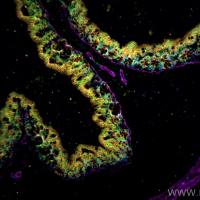Metabolic Labeling with Amino Acids
互联网
- Abstract
- Table of Contents
- Materials
- Literature Cited
Abstract
Metabolic labeling techniques are used to study the biosynthesis, processing, intracellular transport, secretion, degradation, and physical?chemical properties of proteins. This unit provides protocols for metabolic labeling of cells with [35 S]?labeled amino acids to provide material suitable for analysis by immunoprecipitation, for characterization of cellular proteins, for analysis of protein trafficking, and for one? and two?dimensional gel electrophoresis. Three procedures are described for suspension and adherent cells: pulse?labeling, pulse?chase labeling, or continuous long?term labeling. A support protocol describes TCA precipitation to measure the extent of labeling.
Table of Contents
- Safety Precautions for Working with 35S‐Labeled Compounds
- Basic Protocol 1: Pulse‐Labeling of Cells in Suspension with [35S]Methionine
- Alternate Protocol 1: Pulse‐Labeling of Adherent Cells with [35S]Methionine
- Alternate Protocol 2: Pulse‐Chase Labeling of Cells with [35S]Methionine
- Alternate Protocol 3: Long‐Term Labeling of Cells with [35S]Methionine
- Alternate Protocol 4: Metabolic Labeling with Other Radiolabeled Amino Acids
- Support Protocol 1: TCA Precipitation to Determine Label Incorporation
- Reagents and Solutions
- Commentary
- Tables
Materials
Basic Protocol 1: Pulse‐Labeling of Cells in Suspension with [35S]Methionine
Materials
Alternate Protocol 1: Pulse‐Labeling of Adherent Cells with [35S]Methionine
Alternate Protocol 2: Pulse‐Chase Labeling of Cells with [35S]Methionine
Alternate Protocol 3: Long‐Term Labeling of Cells with [35S]Methionine
Alternate Protocol 4: Metabolic Labeling with Other Radiolabeled Amino Acids
Materials
|
Figures
Videos
Literature Cited
| Literature Cited | |
| Braakman, I., Hoover‐Litty, H., Wagner, K.R., and Helenius, A. 1991. Folding of influenza hemagglutinin in the endoplasmic reticulum. J. Cell Biol. 114:401‐411. | |
| Coligan, J.E., Gates, F.T. III, Kimball, E.S., and Maloy, W.L. 1983. Radiochemical sequence analysis of metabolically labeled proteins. Methods Enzymol. 91:413‐434. | |
| Lathe, R. 1985. Synthetic oligonucleotide probes deduced from amino acid sequence data. Theoretical and practical considerations. J. Mol. Biol. 183:1‐12. | |
| Meisenhelder, J. and Hunter, T. 1988. Radioactive protein labelling techniques. Nature 335:120. | |
| Key Reference | |
| Coligan et al., 1983. See above | |
| Contains a detailed description of conditions used to metabolically label proteins with different radiolabeled amino acids. |









